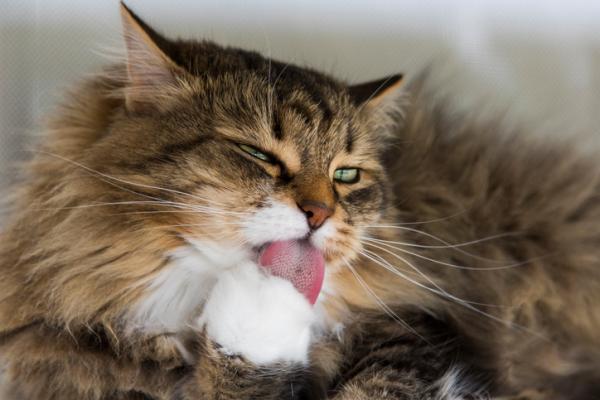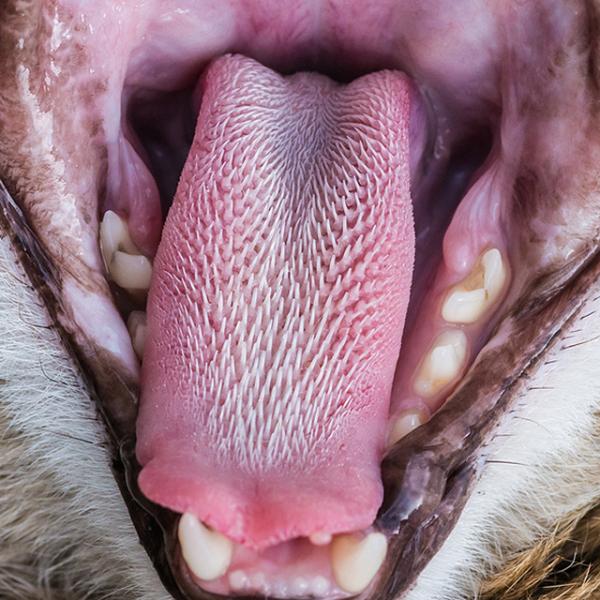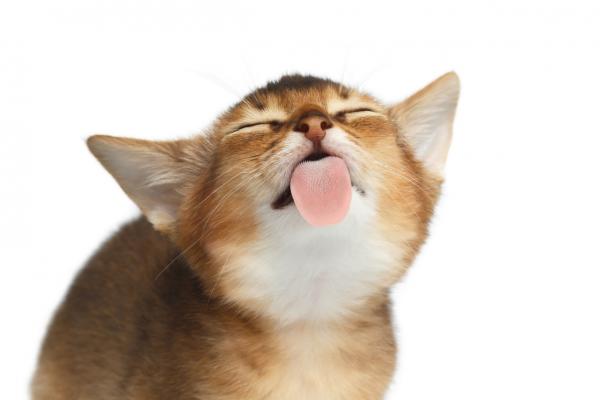Why do cats have a rough tongue?

Do you remember the first time a cat licked your hand? You were probably surprised by the feeling that this act caused on your skin, as if it were a sandpaper instead of a tongue. This is because of the rough surface that makes up the tongue of all cats, which, in addition, is characterized by being very long and flexible, able to reach virtually any part of your body. So, if you’re wondering if it’s normal for your cat to have a rough tongue, the answer is yes. Now, what function does it have? In solving this and more questions, and we will answer the question why cats have rough tongue, keep reading!
How is the cat’s tongue?
Before going into the explanation that justifies the rough tongue of cats, it is important to talk about their anatomy in general. So, the tongue it is a muscular organ which is part of the digestive system, is located, mostly, within the oral cavity and its caudal portion extends to the beginning of the pharynx. In this way, and as with humans and other animals, the tongue plays a key role during the chewing process. In addition, it is covered in its entirety by a paved and keratinized stratified epithelium, with sensors that allow taste and sensitivity.
The language is composed of three different parts:
- Vertex of the tongue, corresponding to the tip. In the ventral part of the vertex is a fold that fixes the tongue to the oral cavity called lingual frenulum.
- Body of the tongue, belonging to the central part of the tongue, closer to the molars.
- Root of the tongue, referring to the area closest to the pharynx.
Although all the animal species have these parts, each of them presents notable differences in terms of form. Likewise, the lingual papillae are another of the most relevant components of the language, a component that can also be modified in each species in relation to the types of papillae and their quantity.
However, they are the taste buds those that make the cat have such an exquisite palate. You probably already have realized this if you live with one, since it is not an animal that accepts any dish of food. This is because cats feel with much more precision the flavor of each ingredient. For them everything is important, from the smell of the food to the texture and, of course, the flavor. Felines, unlike most dogs, only eat what they really like.

But. Why is the tongue of cats so rough?
Cats have in their language a layer of thorny tissue that gives it that feeling of roughness and even reminds us of the touch of a sandpaper when licking us. This fabric is nothing other than calls conical papillae, formed by keratin, which is the same substance that makes up the nails and hair. These thorns have a clear function: act as a comb. Yes, they are part of your language to encourage the care of the hair, repeating the dead fur, cleaning the new one in depth and brushing it. This function has a clear disadvantage, and that is that it promotes the formation of hairballs. Therefore, it is necessary to pay attention to the behavior of the cat, brush it regularly and go to the vet before any anomaly.
Another function to highlight of the conical papillae is to help the cat to remove more easily the meat adhered to the bones of its prey. The feline is a born hunter and, as such, requires certain characteristics that encourage this activity and facilitate food intake as much as possible. Of course, domestic cats no longer need to use their tongue for this purpose, unless they follow a BARF or homemade diet, however, many of them still retain their hunting instincts and do not miss the opportunity to hunt small animals like mice or birds.
As a curious fact, did you know that cats do not only have spines on their tongues? The males also present them in the penis!

Cat tongue functions
In addition to the functions mentioned above, the language of the cats is rough for other reasons:
- Drinking water. Unlike humans and other animals, cats do not use their lips to drink water, they use their tongue creating a kind of spoon to take the desired amount and take it to the oral cavity. If you have never noticed before, watch your cat when he drinks water and see what happens. Also, do not miss our article on “How much water should a cat drink a day?” To confirm that your furry companion consumes the right amount.
- Perceive the taste of meals. As we said, the cat’s taste buds, located on his tongue, allow him to distinguish many more nuances than ours. In this sense, in general, most cats prefer salty foods.
- Control your body temperature. When the cat feels excessive heat, he can use panting to refresh his body and balance body temperature. Thus, it expels the heat through the moisture that it creates in the mucous membranes of the tongue, throat and mouth, making possible the exhalation of this air and the absorption of the vapor obtained to cool down.

Did the cat eat your tongue!
Surely you have heard this popular expression more than once when, for whatever reason, you do not want to talk. Well, according to the legend, this well-known phrase originated in the year 500 BC, when they cut the tongues of the defeated soldiers and evildoers to offer them to the Cat King.
However, this is not the only story that surrounds this saying. In this way, other people believe that the expression took place at the time of the Inquisition, when the tongues of the witches were cut to give them to the cats as food. Tell us, do you know another legend that explains the origin of the expression “did the cat eat your tongue“? If so, leave your comment to share!
If you want to read more articles similar to Why do cats have a rough tongue?, we recommend that you enter in our Curiosities section of the animal world.


